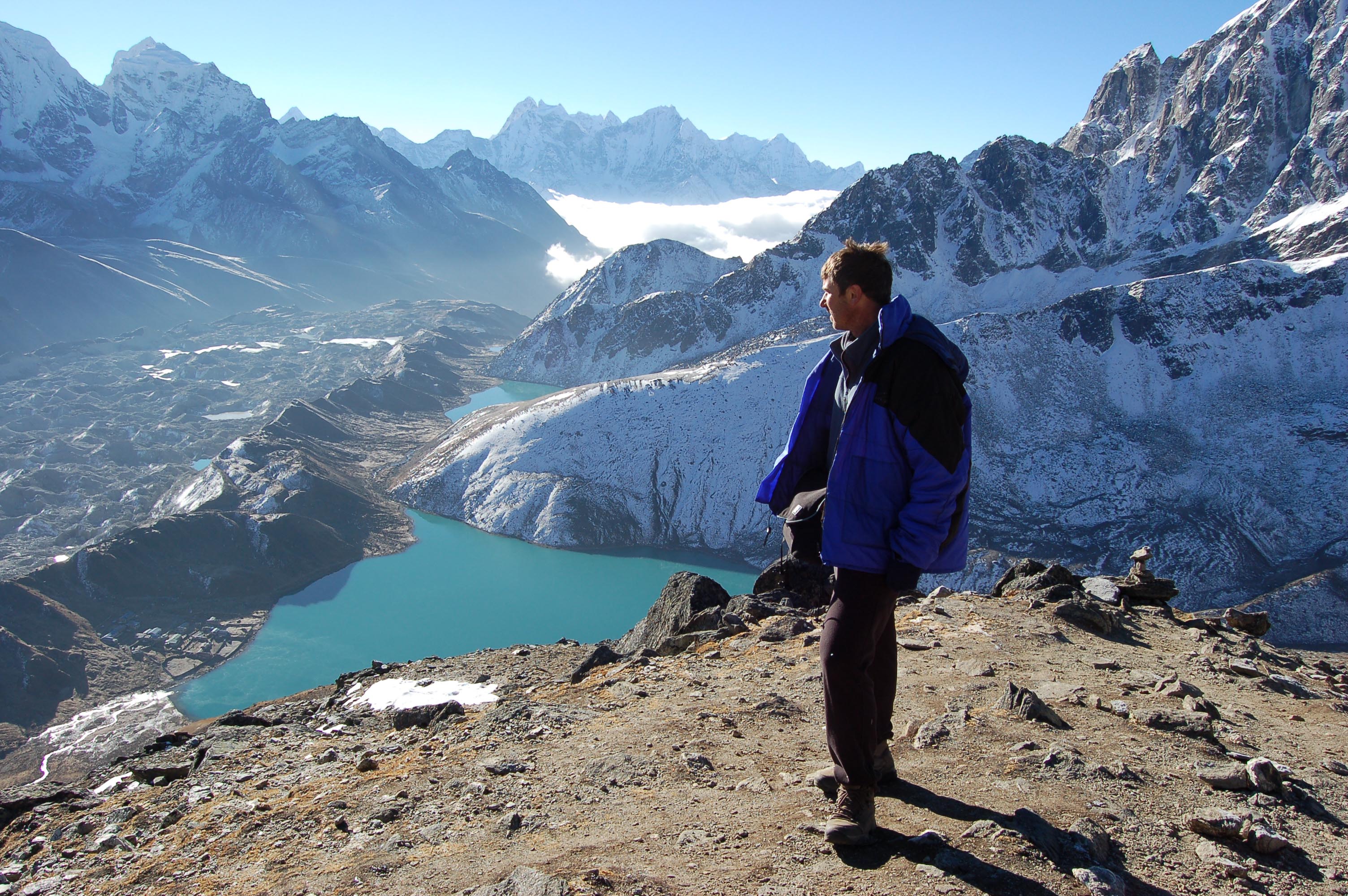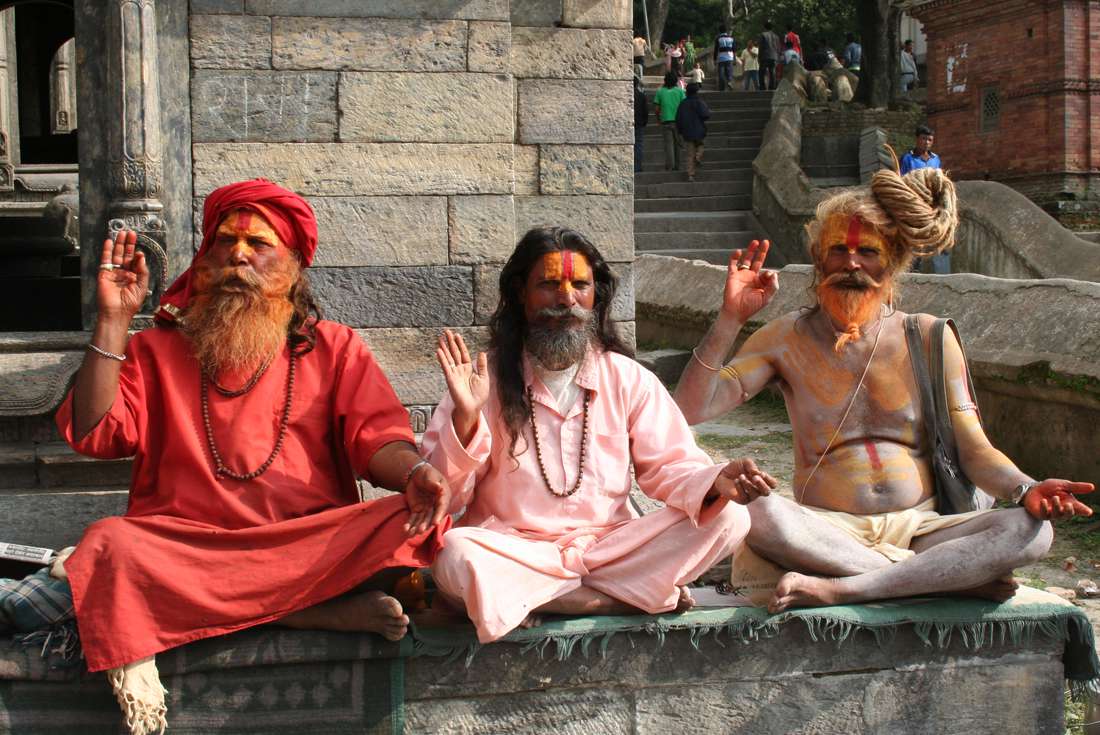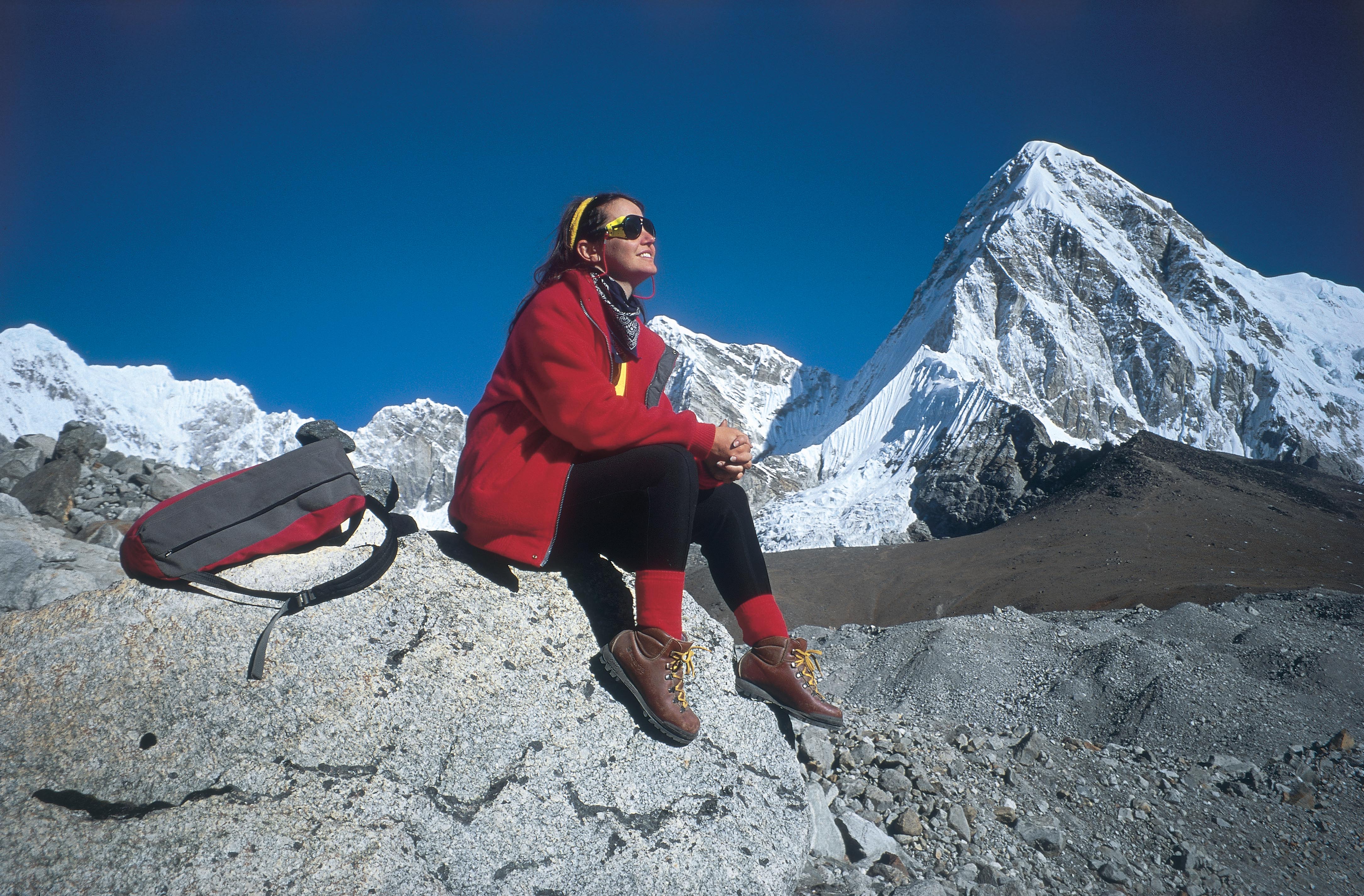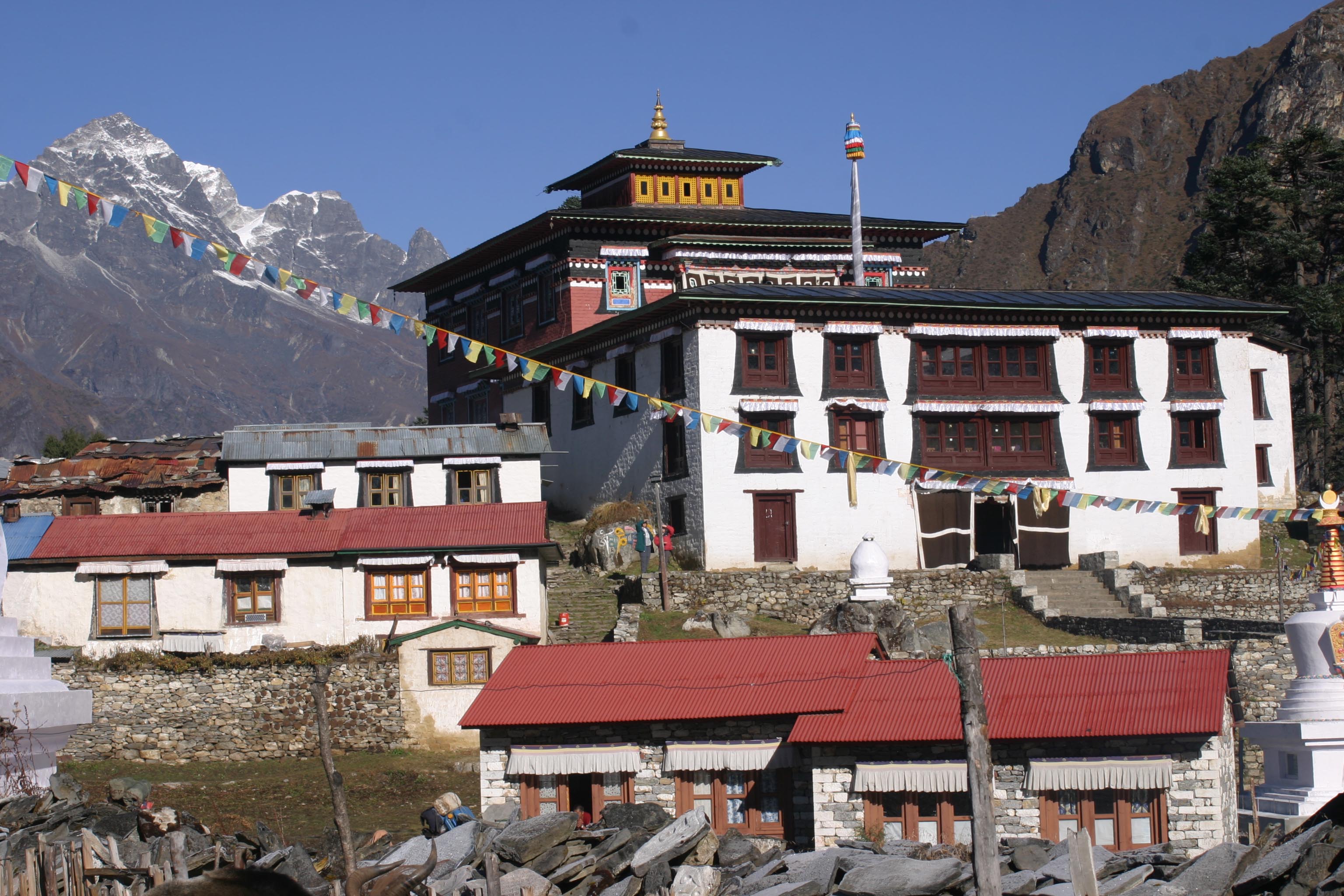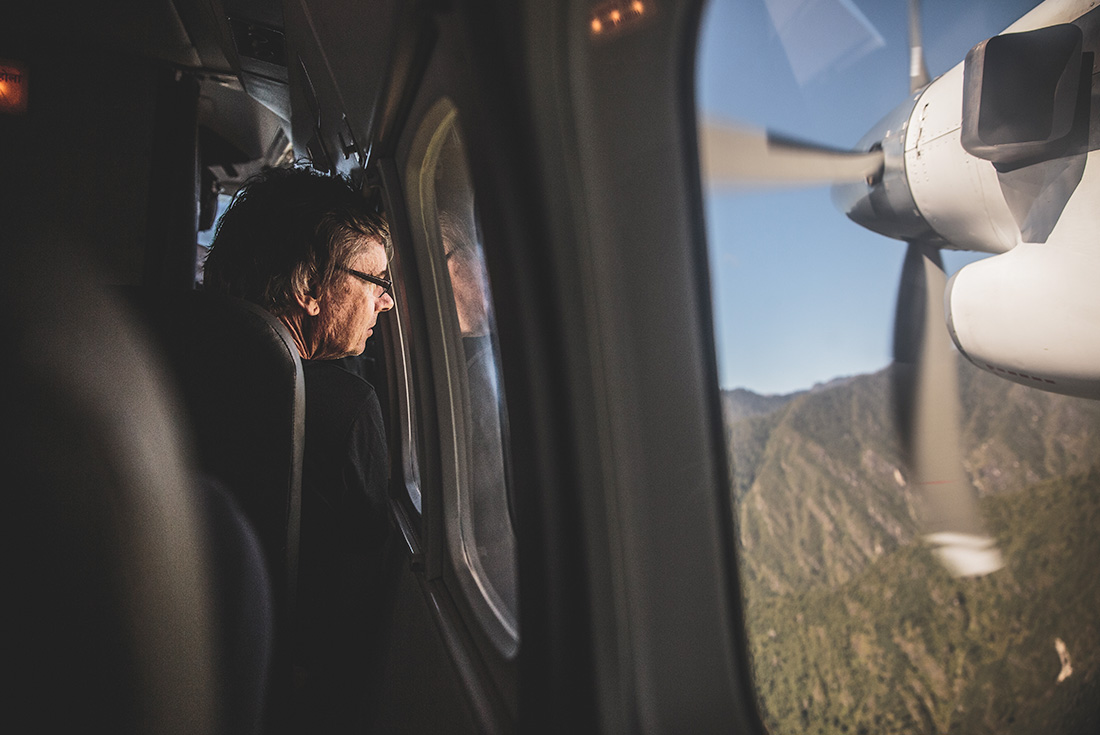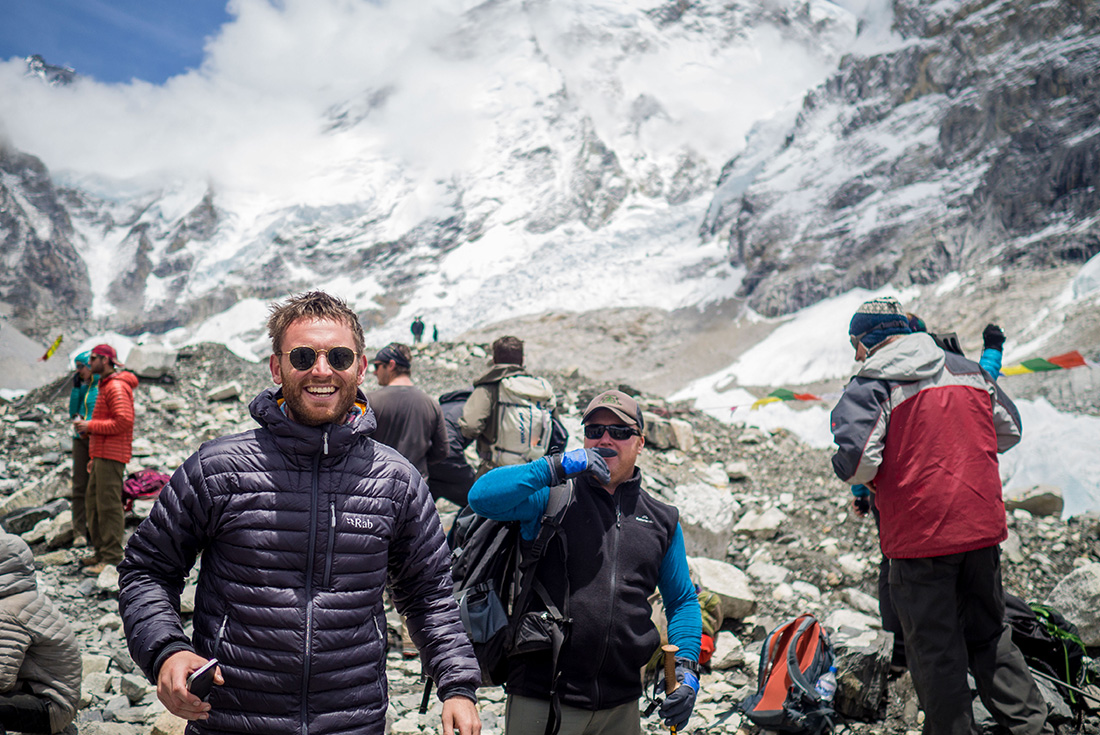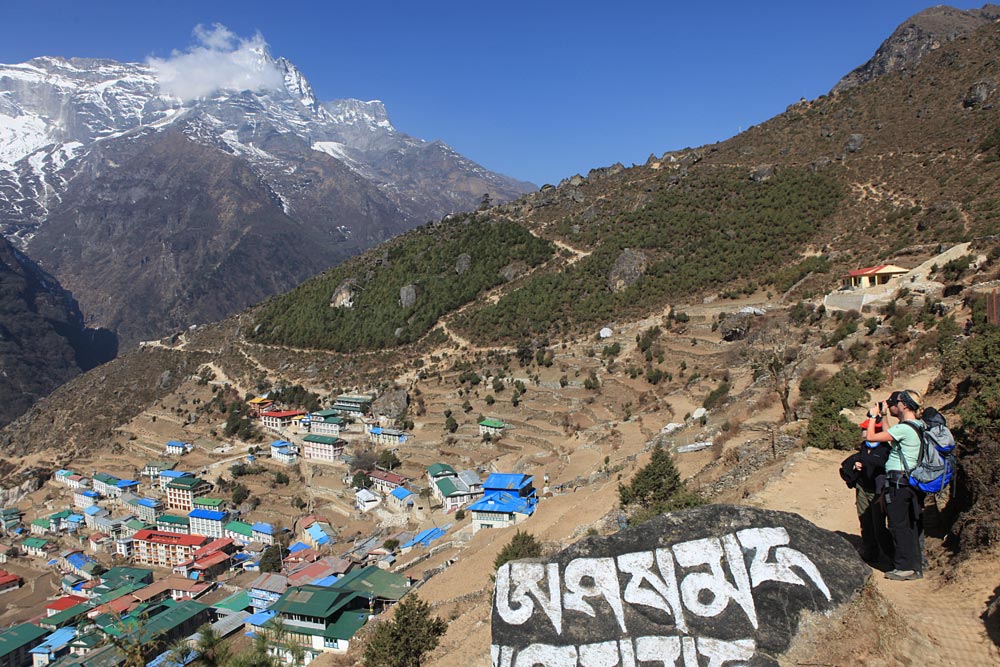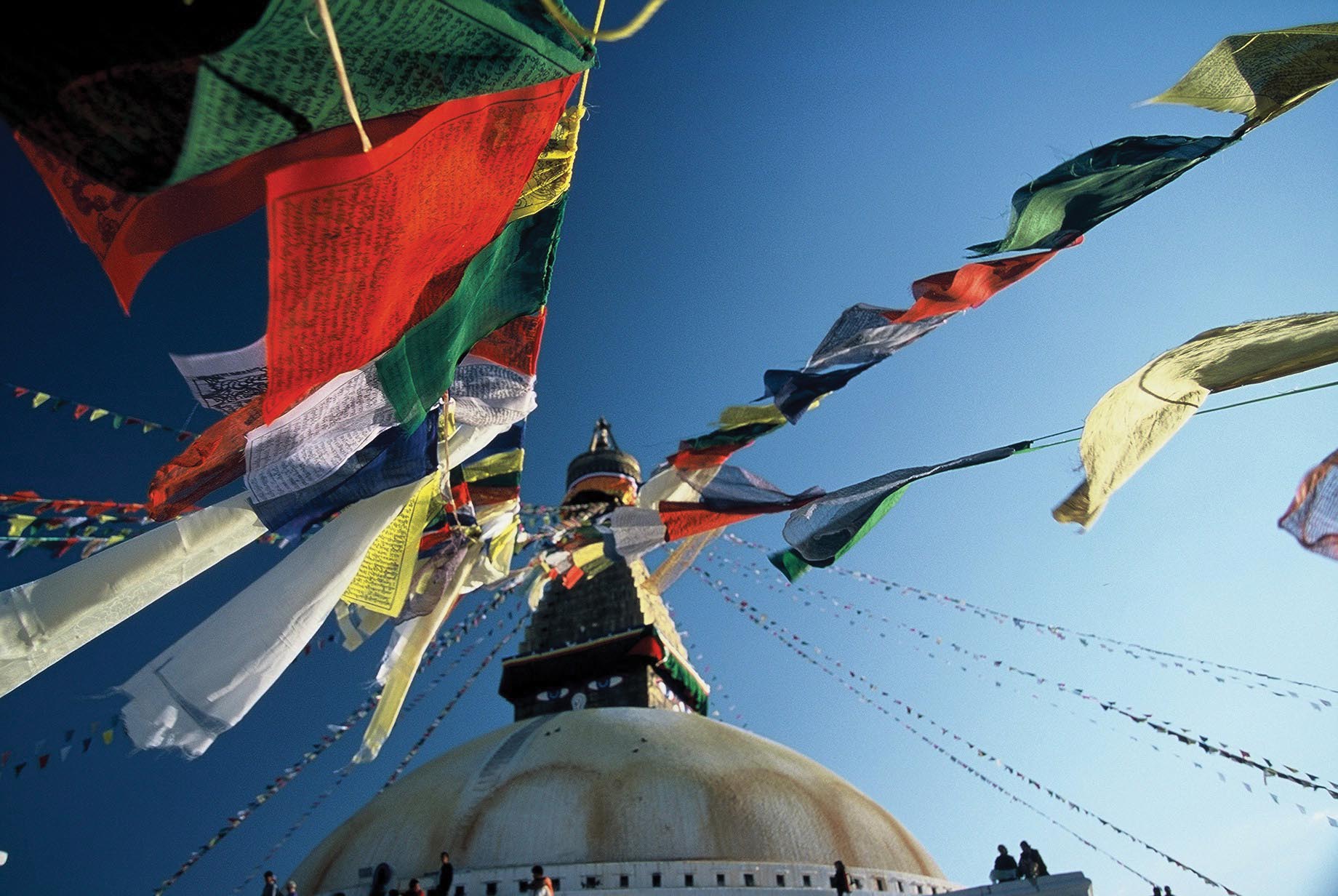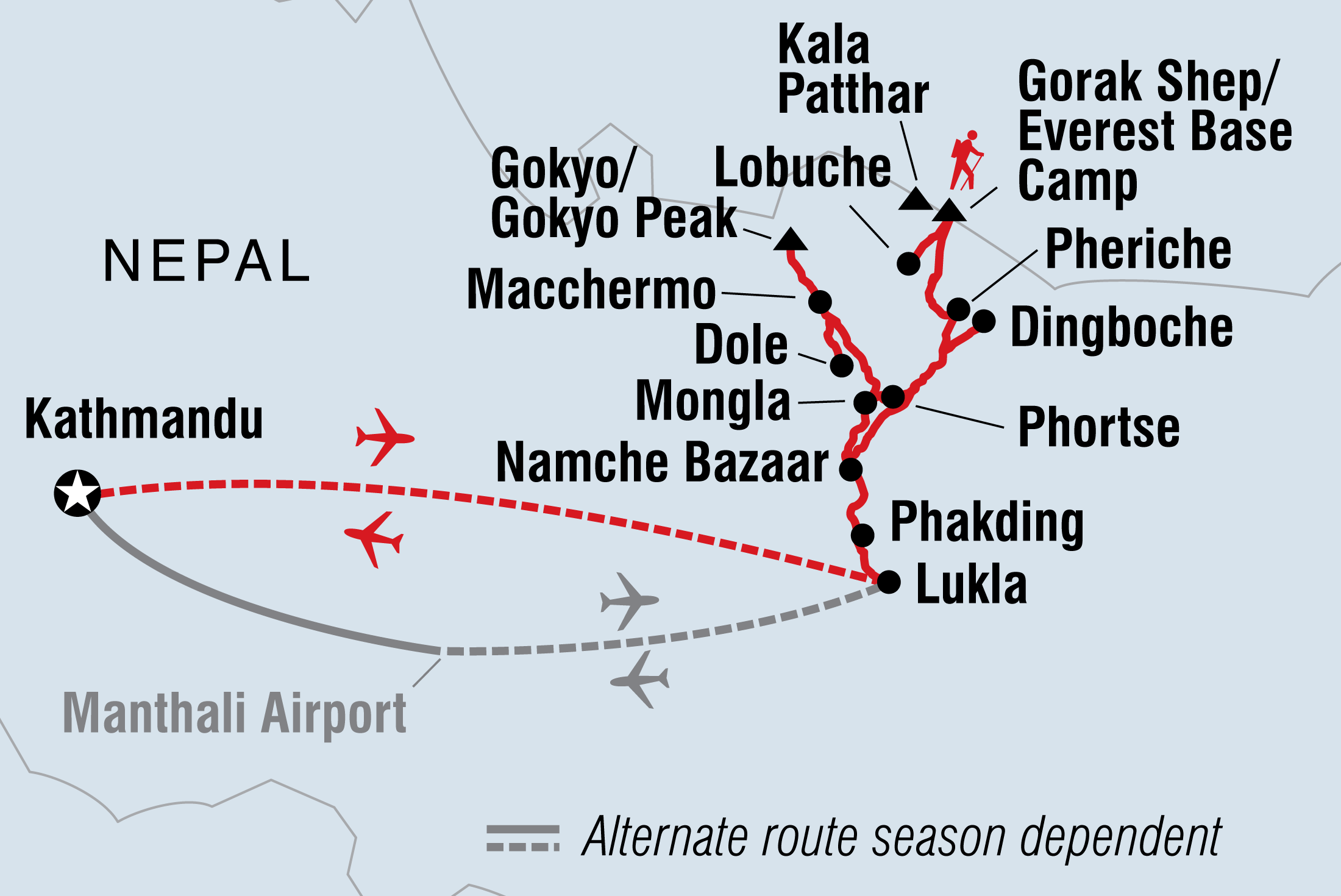Everest Base Camp & Gokyo Lakes Trek
Everest Base Camp & Gokyo Lakes Trek
$2305
Everest Base Camp & Gokyo Lakes Trek
19 Days Starting and ending in Kathmandu
Visiting: Kathmandu, Phakding (2610 m/8563 ft), Namche Bazaar (3440 m/11,286 ft), Mongla (3970 m/13,025 ft), Dole (4038 m/13,248 ft), Machhermo (4465 m/14,649 ft), Gokyo (4720 m/15,486 ft), Phortse (3810 m/12,500 ft), Dingboche (4410 m/14,469 ft), Lobuche (4910 m/16,109 ft), Gorak Shep/Everest Base Camp (5140 m/16,864 ft), Kala Pattar/Pheriche (4240 m/13,191 ft), Lukla (2840 m/9318 ft), Kathmandu
Tour operator:
Tour code:
HNXL
Guide Type:
Fully Guided
Group size:
1 - 12
Age range:
15-99 years
Tour operated in:
EnglishTrip Styles:
Tour Overview
Embark on an unforgettable 19-day adventure into the heights of the Himalayas, and earn the right to say you've conquered the challenge of reaching Everest Base Camp. Fly into Lukla from Kathmandu, then hit the trails of Sagarmatha National Park. Explore the mountains and valleys around the towering peak, rest in teahouses and take the path less travelled into the stunning Gokyo Lakes region. Then, it’s upwards and onwards to Base Camp, sitting a cool 5364 m above sea level. With the help of your expert leader you’ll learn about Nepalese culture as you go, and you’ll feel the support of your like-minded travellers. ALTERNATE ITINERARY: In case of weather conditions leading to cancellations or delays in flights, this trip will operate on an alternate itinerary. Please see Day 1 of the itinerary for more details.
Highlights
Itinerary
Day 1: Kathmandu
Location: Kathmandu
Accommodation: Hotel
Namaste! Welcome to Nepal. Your adventure begins with a welcome meeting at 2 pm today. If you touch down early, there’s much to do in Kathmandu. Maybe head out into the streets of Pashupatinath (home to markets, bazaars, holy men, monks, bicycles and sacred cows), climb to Kathmandu’s most important Buddhist shrine Swayambhunath (also known as the ‘monkey temple’) or feel out the atmosphere in Durbar Square. After your meeting the evening is free, so you might like to try out one of Kathmandu’s many restaurants with your new travel companions.
ALTERNATIVE ITINERARY DUE TO FLIGHT CANCELLATIONS:
Weather conditions in the Himalayas can change rapidly, which frequently results in the need for changes to be made to our intended itineraries. Flights throughout Nepal, particularly in high mountain areas, can be delayed or cancelled due to poor weather conditions. Flights between Kathmandu and Lukla are particularly prone to these delays which has the potential to vary the itinerary of all departures in the Everest region. Our contingency plans in case of bad weather preventing the fixed wing aircraft flight from Kathmandu to Lukla are as follows:
Day 2 - We will attempt to board our booked fixed wing flight as per the itinerary. If this flight is cancelled we will return to our hotel in Kathmandu for an additional night.
Day 3 up to Day 6 We will again attempt to board our booked fixed wing flight. If this flight is cancelled but helicopters are available and permitted to fly to Lukla we will use our best endeavours to charter a helicopter to transport the group. Travellers will need to use their emergency fund to cover the cost of this chartered helicopter. The exact cost will depend on how many travellers are in your group and could be up to US$500. It is common practice for the helicopter company to charge varying prices, so you may pay different amounts to others on the flight. If we reach Lukla on Day 6 by either fixed wing aircraft or helicopter we will then follow the itinerary to Everest Base Camp. We will not be able to reach Gokyo Lakes however, we still have enough time to reach Everest Base Camp at a safe rate of ascent.
Day 7 - If both fixed-wing planes and helicopters are unable to reach Lukla on Day 6, then on Day 7 we will drive back to Kathmandu by private vehicle. While we will not be able to visit the Gokyo Lake and Everest Base Camp itself on the altered itinerary to Langtang - Gosainkunda Trek, our travellers have still found it a highly enjoyable trek with superb views of snow caped mountains and visit the beautiful lake - Gosainkunda. This lake is sacred for both Hindu and Buddhist pilgrims.
We also advise allowing a few extra days in Kathmandu at the end of your trip should your return flights from Lukla be delayed due to weather conditions.
Optional Activities:
-
-
-
Day 2: Phakding (2610 M/8563 Ft)
Location: Phakding (2610 m/8563 ft)
Accommodation: Teahouse
Early this morning you’ll board a plane for a quick journey from Kathmandu to Lukla (2827 m). This is no regular flight – you’ll be flying parallel to the giants of the Himalayas and, if the weather’s good, make sure to secure a seat on the left for amazing views of the mountains bordering Nepal and China. Touch down on the airstrip, then it’s time to meet your porters and take some time to warm up with an exploration of the village of Lukla. After a quick safety talk, gear up and begin your trek to Phakding. You’ll descend towards the milky white waters of the Dudh Kosi River, where you’ll join the main trail to Namche Bazaar, located just above Chaunrikharka (2713 m). The walk is easy and after passing through the small village of Ghat (2550 m), it’s only a short walk to Phakding.
Included Activities:
-
-
Day 3: Namche Bazaar (3440 M/11,286 Ft)
Location: Namche Bazaar (3440 m/11,286 ft)
Accommodation: Teahouse
Today you’ll trek to Namche Bazaar, where you’ll spend two nights acclimatising to the altitude – and might even get your first look at Everest itself. From Phakding, you’ll begin to head up the valley. The trail, lined with blue pine forest, follows the river valley and is especially spectacular in spring when the rhododendron flowers are bright in bloom. Cross the Dudh Kosi river at Benkar, and look way up above 6,000 metres to see the peaks of snow-capped Kusum Kanguru (6369 m) and Thamserku (6623m). Press on to Monjo (2835m), a good place to break for lunch. From here the walk starts to get a little tougher, with a steep ascent to Namche Bazaar. Enter into the national park, cross the river through the village of Jorsale (2805m) and then continue upstream. Cross the spectarular Hillary Bridge and begin the ascent to Namche Bazaar. Get your camera out as on a clear day you’ll get your first glimpse of the peaks of Everest, Lhotse, Nuptse and Taweche. Namche will be your last chance to check your equipment and hire any additional gear for the high altitudes from Dingboche onwards.
Day 4: Namche Bazaar (3440 M/11,286 Ft)
Location: Namche Bazaar (3440 m/11,286 ft)
Accommodation: Teahouse
You’ll stay at Namche Bazaar for another night so that you can properly acclimatise to the altitude. One of the best ways to do this is to take a strenuous walk up to a high altitude then come back down to sleep. Your optional (but recommended) walk today will take you to see views from the Tenzing Norgay Memorial and Sagarmatha National Park Museum above the village. If the conditions are right, this stunning vista includes a panorama of the Khumbu peaks and great views of Everest. The national park museum is also home to interesting displays about Sherpa lifestyle and culture, and the local flora and fauna. Then, continue your hike to higher elevations with a visit to Sagarmatha Next, who support local communities to create and implement a sustainable waste handling systems in the region. Return to town and enjoy a free rest of your day. Namche gained its importance during the period when Tibetan salt was traded for the lowland grains of Nepal. There's still a roaring trade in the village centre, so be sure to use this chance to stock up on any extra supplies you might need.
Included Activities:
-
Day 5: Mongla (3970 M/13,025 Ft)
Location: Mongla (3970 m/13,025 ft)
Accommodation: Teahouse
From Namche ascend to the airstrip at Shyanboche, then on to a lunch spot in Khumjung, the largest village in the region. Here you can fill up on dhal bhat, noodles and more, after lunch opt to enter the Khumjung Buddist Monastery. Towering above Khumjung is the sacred rocky peak of Khumbilya (5761 m). It’s the home of the guardian goddess of the region, often depicted in religious paintings (or thangkas) as a white-faced figure on a white horse. The trail winds around Khumbilya's lower slopes, passing through beautiful birch forest and then climbing from treeless, grassy slopes to a stupa on top of a rocky ridge (3992 m). Once again the views of the surrounding mountains are magnificent. Phortse can be seen across the valley – a picturesque village set in a patchwork of stone walled fields. You’ll stay overnight at the cluster of lodges on the saddle, known as Mongla.
Optional Activities:
-
Day 6: Dole (4038 M/13,248 Ft)
Location: Dole (4038 m/13,248 ft)
Accommodation: Teahouse
The altitude can make things tough, so be sure to take it easy over the next three day and don’t push yourself too hard. From Mongla, descend on a series of switchback trails to the Dudh Kosi River at Phortse Bridge. The trail to Gokyo can be deceptive and some can ascend too quickly, but you’ll take your time. Leaving Phortse Bridge, you’ll ascend steeply at first and then contour high above the valley, enjoying excellent views (truly, every view is beyond excellent) of Kantega, Thamserku and Ama Dablam (6856 m). About an hour's walk from Phortse Bridge, you’ll get your first views of the mammoth peak of Cho Oyo (8153 m) at the head of the valley. Trek beyond the tree line and pass some imposing waterfalls on route to the yak herding settlements of Tongba (4015 m) and Gyele (4050 m). From here it’s a short distance to Dole, where you’ll spend the night. You’ll also explore the upper Dole Valley while you’re here, returning via a high ridge above the lodge to take some incredible photos of Cho Oyo and Gyachung Kang (7922 m) to the north, and Taweche (6542 m) and Cholatse (6440 m) across the valley to the east.
Day 7: Machhermo (4465 M/14,649 Ft)
Location: Machhermo (4465 m/14,649 ft)
Accommodation: Teahouse
You might come to appreciate the term ‘short walking day’. Today will be just that, with a climb out of the small Dole Valley before a gradual ascent up the Dudh Kosi Valley, high above the river. Though the walk is quite easy you’ll definitely start to feel the effects of altitude on even the smallest hill. The barren alpine scenery, with only small clusters of scrub juniper, is a stark contrast to the snowy white peaks and deep blue skies. After a couple of hours you’ll arrive at Luza (4360 m), then soon enough you’ll reach the lodge at Machhermo – tonight’s accommodation. If you’re still feeling energetic, then after lunch there’s the option to take an excursion across rocky rubble to the base of Kyajo Ri (6168 m) and Machhermo Peak (6073 m). Watch out for a yeti though – it was spotted here in 1974 when three yaks were killed and a Sherpa girl was injured when trying to fight off a hairy, ape-like intruder!
Day 8: Gokyo (4720 M/15,486 Ft)
Location: Gokyo (4720 m/15,486 ft)
Accommodation: Teahouse
Today you'll need a new word to describe the colour blue after seeing the Gokyo Lakes. A short, steep climb leads from the Machhermo Valley on to the steep grassy slopes of the Dudh Kosi Valley. Keep an eye open for the colourful Tibetan snow cocks, often found in this area. The valley widens as you pass through Pangka (4390 m) and on to the jumbled moraines (glacier debris) of Ngozumpa Glacier, the largest in Nepal and the source of the Dudh Kosi River. Climbing steeply over a rocky trail you’ll keep to the western side of the glacier to reach a small lake at the head of a wide valley and then pass a larger lake at Longpongav (4690 m), before following the lateral moraines to the third lake at Gokyo (4750 m). Gokyo has a number of stone dwellings surrounded by stone walled yak pastures. Today’s lodge is located close to the lake and, if there are no clouds around, the sunroom will be lovely and warm in the afternoon. For those feeling energetic, it’s worth ascending to the ridge at the back of Gokyo for views down to the mighty Ngozumpa Glacier.
Day 9: Machhermo (4465 M/14,649 Ft)
Location: Machhermo (4465 m/14,649 ft)
Accommodation: Teahouse
Get up early for a couple of hours climb up Gokyo Peak, which has one of the best panoramas in the Khumbu region. It’s a straightforward but steep climb, and it can be tiring due to the altitude. View four 8,000 metre-plus peaks – Everest (8848 m), Cho-Oyo (8153 m), Lhotse (8511 m) and Makalu (8481 m) – and spot countless other towering peaks including Gyachung Kang (7922 m) to the east of Cho-Oyo, Cholatse (6440 m), Taweche (6542 m) and Kangchung (6103 m). There’s also a bird's eye view of the Gokyo lakes and the huge creaking Ngozumpa Glacier, now cutting halfway across the world and snaking its way down the valley far beneath. You’ll descend back to Gokyo for a late breakfast and then retrace your steps back to the snout of the glacier and continue down the valley back to Machhermo. You might be surprised easily and quickly you’ll cover the return route – that’s acclimatisation!
Day 10: Phortse (3810 M/12,500 Ft)
Location: Phortse (3810 m/12,500 ft)
Accommodation: Teahouse
Not many groups stop in Phortse – a traditional Sherpa village that offers an insight into their life and culture – so today will be something special. A leisurely start to the day will wind you down the valley to Dole, where you’ll enter the forest to continue the descent to Phortse Bridge. Keep an eye open for musk deer, which are often seen on this section of the trail. Here you’ll stop for lunch and then branch off the main trail to Namche, crossing the Dudh Kosi and ascending to the village of Phortse, where few trekkers pass on their Everest trek. The dramatic mountain views, peace and quiet of this village make this one of the highlights of the trek. Here you’ll be almost completely above the treeline, so the sunsets make for perfect pictures.
Day 11: Dingboche (4410 M/14,469 Ft)
Location: Dingboche (4410 m/14,469 ft)
Accommodation: Teahouse
This morning's walk will take you across a ridge before descending on an exposed trail to the Imja Khola. Keep an eye open for Himalayan tahr, often seen perched precariously on the crags high above the trail. Join the trail coming from Thyangboche via the suspension bridge, then gradually climb to the village of Pangboche, where the peak of Ama Dablam dominates the skyline. Have lunch here and then, if it is open, take the opportunity to see the beautiful monastery that once housed (what was claimed as) the hand and scalp of a yeti. After lunch, follow the trail high above the Imja Khola, passing the tea houses at Orsho, before again crossing the Imja Khola and old glacial moraines to a lodge Dingboche. Here you’ll find a beautiful patchwork of small fields enclosed by stone walls. These walls protect crops of barley and potatoes from the cold winds. The scenery is once again spectacular and although Everest will be hidden behind the Lhotse-Nuptse Ridge, the huge peaks that tower above the eastern end of the valley are more than worthy. If the weather’s right, then there will be gorgeous sunsets illuminating the peaks – Ama Dablam, the south face of Lhotse to the north and also Island Peak in the centre of the valley.
Day 12: Lobuche (4910 M/16,109 Ft)
Location: Lobuche (4910 m/16,109 ft)
Accommodation: Teahouse
From Dingboche, ascend the small ridge behind the village above the Pheriche valley. From the stupa at the top, Taweche and Cholatse (6440 m) make for a pretty striking scene as they seem to lean forwards from across the valley in the west. To the north, Lobuje Peak (6119 m) and the snowfields of the Cho La are the kings of the skyline. The walking will now be fairly flat on wide-open fields, but remember that there’s no rush – take your time and ensure you’re well hydrated. Late in the morning you will cross the Khumbu Khola at Dughla and take a light lunch at the foot of the huge terminal moraines of the Khumbu Glacier flowing off Everest. In the afternoon, there will be a solid and quite steep climb on a rocky trail to the top of the moraines. On the crest of the ridge, you’ll pass a line of memorial cairns (stacks of stones), built in memory of the Sherpas and climbers who have died on various Everest expeditions over the last fifty or so years. From here the view is downright spectacular once again, with Pumori (7145 m), Lingtren (6697 m), Khumbutse (6623 m), and across the border in Tibet, Changtse (7550 m), surrounding you. Then follow the valley stream to the lodge at Lobuche, arriving early afternoon. No doubt you’ll be tired, but remember tomorrow’s plan – Everest Base Camp.
Day 13: Gorak Shep/Everest Base Camp (5140 M/16,864 Ft)
Location: Gorak Shep/Everest Base Camp (5140 m/16,864 ft)
Accommodation: Teahouse
This is the big one, the day of Everest Base Camp. From Lobuche, follow the broad valley that runs parallel to Khumbu Glacier, with a gradual ascent enabling you to build the slow, steady rhythm required when walking at high altitude. When you reach the moraines of Changri Nup Glacier, you will make a series of small ascents and descents over a rocky trail lined with cairns that eventually leads to the surprising glacial sands of Gorak Shep (5160 m) – reached after about three hours of walking. Now’s the time to grab a quick bite, gear up appropriately and then head off towards Everest Base Camp. The trek can be achieved in around three hours, and if trekking in the popular climbing period of March to May, you’ll almost certainly encounter yaks and porters supplying food and equipment to expeditions here. From Everest Base Camp you won’t get views of Mount Everest, but you are able to see glorious glaciers, lakes, caves and the notorious Everest Ice Fall that flows from the Western Cwm. The return journey from the Base Camp to Gorak Shep takes the same amount of time. You’ll have an early dinner so that you are able to get up early the next day for awe-inspiring views of the Himalayan giants from Kala Patar.
Day 14: Kala Pattar/Pheriche (4240 M/13,191 Ft)
Location: Kala Pattar/Pheriche (4240 m/13,191 ft)
Accommodation: Teahouse
Today you’ll see some of the Himalayas’ most recognisable sights. Make an early start to avoid the early morning clouds and trek to Kala Pattar (5545 m) to witness the best views of Everest. The ascent is quite steep and made more difficult because of the altitude, so start very slowly and try to ascend at a steady rhythmic pace. Kala Patar is the rocky hilltop below Pumori, and Nuptse, Changtse, Ama Dablam, Taweche, Kantega and Everest – they’re all here. About three kilometres away and some 200 metres below, the area of the Everest Base Camp can be seen in a bowl at the bottom of the Khumbu Ice Fall. Spend as long as you like to savour an extra special moment, then it’s all downhill from here – the descent to Gorak Shep is easy and when you arrive back at the lodge you’ll have a quick drink and head off to the rooms to pack your kit bags while breakfast is being prepared. After breakfast set off to Lobuche and Thugla, where you’ll stop for lunch. Then cross the Khumbu Khola and head down the valley below Cholatse to Pheriche, where you’ll stop for the night.
Trek Distance: 4 Kilometres
Trek duration: Approximately 3 hours
Gorakshep – Pheriche (4240m / 13911ft) :
Trek Distance: 12 Kilometres
Trek duration: Approximately 5 - 6 hours
Day 15: Namche Bazaar (3440 M/11,286 Ft)
Location: Namche Bazaar (3440 m/11,286 ft)
Accommodation: Teahouse
From Pheriche, cross the Khumbu Khola River and ascend a short steep trail to the top of a small ridge for great views of Imja Valley, Ama Dablam and Kantega. Descend through the small settlements at Orsho and Shomare before passing through Lower Pangboche. Here you’ll reach the suspension bridge over the Imja Khola River, then ascend back to Thyangboche to visit the monastery. According to legend, Lama Sange Dorjee, who came from Tibet’s Rongphu Monastery, founded Thyangboche Monastery in the 17th century. Thyangboche was destroyed by an earthquake in 1933, rebuilt and again badly damaged by a fire in 1989. Construction of the present monastery was completed in 1992. Spend a bit of time visiting the monastery and the nearby museum. In the afternoon, descend steeply through beautiful forest of juniper, rhododendron and fir to Phunkitenga. After a welcome break and perhaps a cup of tea, you will cross the Dudh Kosi River and ascend to Trashinga. From here the trail contours high above the valley through Shanasa and on to Namche Bazaar, where you’ll spend the night.
Day 16: Phakding (2610 M/8563 Ft)
Location: Phakding (2610 m/8563 ft)
Accommodation: Teahouse
Take some time to enjoy your final opportunity to visit the shops in Namche Bazaar, before descending steeply down to the large Hillary Bridge over the Dudh Kosi River. You’ll follow the trail through Jorsale and back to Monjo, where you’ll stop for lunch. In the afternoon it’s only a short walk via Benkar through blue pine and rhododendron forest, with great views of Kusum Kangaru, back to the lodge in Phakding.
Day 17: Lukla (2840 M/9318 Ft)
Location: Lukla (2840 m/9318 ft)
Accommodation: Teahouse
You’ve done it, your last day of trekking! It’s only a short walk in the valley before making the final climb up to the airstrip at Lukla, where you’ll say goodbye to your crew. Celebrate with a hot shower and a few drinks with your group before flying back to Kathmandu tomorrow morning.
Day 18: Kathmandu
Location: Kathmandu
Accommodation: Hotel
Weather permitting, take the short flight from Lukla to Kathmandu this morning. Return to your accommodation and then enjoy some free time during the afternoon for further sightseeing or shopping. Located in the south of the city, Patan is also worth a visit with its own Durbar Square full of historic structures and statues of past kings. This evening it’s time to celebrate with a tongba (hot millet beer) and a plate of ziva (pastry fingers filled with cheese), while you relax your weary legs with your travelling companions and newfound friends.
Day 19: Kathmandu
Location: Kathmandu
Say ‘dhanyabad’ for memories that’ll last a lifetime. There are no activities planned for today and you are able to depart the hotel at any time. If you'd like to stay longer, just speak to your booking agent.
Optional Activities:
-
-
-
-
What's Included
-
Accommodation
Teahouse (16 nights), Hotel (2 nights) -
Meals
-
Everest Base Camp & Gokyo Lakes - 15D/14N Trek
-
Everest Base Camp & Gokyo Lakes - Porterage of One Bag (10kg/22lbs max)
-
Sagarmatha Next visit
What's Not Included
-
International Travel
-
Tipping and Gratuities
Included Activities
Transport
- LUKLA FLIGHTS
- Flights going to and from Lukla may be operated out of Ramechhap Airport, in an effort to alleviate congestion at Kathmandu’s Tribhuvan International Airport by the Civil Aviation Authority of Nepal. Lukla is the gateway port to the Everest region and flights throughout Nepal – particularly in high mountain areas – are often delayed or cancelled due to poor weather conditions. In order to maximise our chances of boarding a flight to Lukla, any departures affected will need to wake up quite early on Day 2 to drive the 130 kilometres (approximately 5-hours) from Kathmandu to Ramechhap Airport. A private vehicle transfers will be provided at no additional cost. In addition, flights back from Lukla may also land at Ramechhap Airport, therefore sufficient time is needed for land transport back to Kathmandu. Travellers have on occasion missed international connections as a result of this. Ensure you have adequate travel insurance and contact numbers for your airlines before departure.
- LUGGAGE LIMITS:
- Domestic flights in Nepal have strict weight limits - 10kg of check-in luggage and 5kg of carry-on hand luggage per person is included with your flight ticket. Excess baggage (up to 5kg per person only) will be charged at your own expense.
- TRAVEL BETWEEN KATHMANDU & POKHARA:
- On itineraries that include road travel between these destinations, past travellers have often decided to fly this route independently to avoid the long overland journey (200km, approx 6+ hours). The flight takes around 35mins. Should you decide to fly, this will be at your own expense with no refunds for road travel available.
- ROAD TRAVEL:
- Roadworks and infrastructure projects can cause significant delays on major roads within cities and highways between destinations. Road travel can also be disrupted due to demonstrations and bandhs (strikes) without warning. Major roadworks are currently ongoing in and around Kathmandu and the roads to Chitwan National Park. Delays, heavy traffic, poor road conditions and dust are a reality of road travel in Nepal.
- MONSOON:
- The monsoon season is from June to September and weather conditions can disrupt travel during this time due to flooding and landslides. Disruption of air travel and airport closures are also possible. Be prepared that the itinerary may need to change at short notice.
Accommodation
- TEAHOUSES:
- Accommodation at local lodges - better known as teahouses - are simple but comfortable. Toilets and washing facilities are shared and rudimentary, and the food is plain and filling. In a teahouse, travellers are provided with small twin share rooms with twin beds, mattresses and pillows. At times, in high seasons, and in places where there are limited number of teahouses, travellers may have to make do with dormitories. In some places, teahouses don't have access to electricity, depending on solar powered lighting instead. In more remote regions, teahouses don't have running water and toilets can mean just a hole in the ground. Hot shower facilities are available in some teahouses for a price but occasionally a hot shower means a bucket of hot water, enough to wash your body. Electricity to charge devices as well as WiFi is usually for an additional fee when available.
- TEAHOUSE COSTS
- The following approximate costs were correct at time of writing, though varied slightly from teahouse to teahouse:
- Shower - 500 - 600 NPR
- WiFi - 500NPR (Unlimited – valid up to 12 hours)
- Electricity - 250NPR (Per charge)
- Soft Drink - 400-500 NPR
- Mango Juice - 300 - 400 NPR
- Porridge - 500 NPR
- Daal Bhaat - 600 -1000 NPR
Important Information
- 1. This trip starts in Kathmandu on Day 1 at 2 pm. This allows time after the joining meeting to explore Kathmandu.
- 2. Due to the demands of travelling at high altitudes a Passenger Self Assessment Form is required for this trip. You will be trekking on hilly terrain, generally on well-defined paths, walking anywhere between 2-7 hours per day, on average about 5 hours a day. Altitude may exceed 5545 metres.
- 3. A single supplement is available if you’d prefer not to share a room on this trip. The single supplement will only be included on Days 1,18 (Hotel) and is subject to availability. Please speak to your booking agent for further information.
- 4. In case of weather conditions leading to cancellations or delays in flights, this trip will operate on an alternate itinerary. Please see Day 1 of the itinerary for more details.
- 5. Ensure you have access to an extra US$500 for emergencies (e.g. severe weather, natural disasters, civil unrest) or other events that result in unavoidable changes to the itinerary (e.g. transport strikes or cancellations, airport closures). Please be aware that in the event of an emergency evacuation, Intrepid does not have control over which helicopter service may be used. Some helicopters are not in regular use with Intrepid and have not passed our internal safety auditing.
- 6. We advise allowing a few extra days in Kathmandu at the end of your trip should your return flights from Lukla be delayed due to weather conditions.
- 7. The minimum age for this trip is 15 at time of travel.
- 8. You may be asked to provide 2 passport size photographs for your trekking permit.
- 9.Your health and safety is our priority. Your leader may delay or stop your ascent based on your medical conditions and AMS symptoms. Please ensure your insurance includes coverage for activities above 3000m, mountain rescue, and helicopter evacuation costs. Without adequate insurance cover, helicopter evacuation requires upfront payment.
- 10. Please provide your full name and nationality exactly as per passport at the time of booking (including any middle names listed on your passport) for flight tickets. Fees may apply for amendments to details within 30 days of departure, and in some cases, you will be required to cover the cost of issuing new tickets.
Mode of Transport
- LUKLA FLIGHTS
- Flights going to and from Lukla may be operated out of Ramechhap Airport, in an effort to alleviate congestion at Kathmandu’s Tribhuvan International Airport by the Civil Aviation Authority of Nepal. Lukla is the gateway port to the Everest region and flights throughout Nepal – particularly in high mountain areas – are often delayed or cancelled due to poor weather conditions. In order to maximise our chances of boarding a flight to Lukla, any departures affected will need to wake up quite early on Day 2 to drive the 130 kilometres (approximately 5-hours) from Kathmandu to Ramechhap Airport. A private vehicle transfers will be provided at no additional cost. In addition, flights back from Lukla may also land at Ramechhap Airport, therefore sufficient time is needed for land transport back to Kathmandu. Travellers have on occasion missed international connections as a result of this. Ensure you have adequate travel insurance and contact numbers for your airlines before departure.
- LUGGAGE LIMITS:
- Domestic flights in Nepal have strict weight limits - 10kg of check-in luggage and 5kg of carry-on hand luggage per person is included with your flight ticket. Excess baggage (up to 5kg per person only) will be charged at your own expense.
- TRAVEL BETWEEN KATHMANDU & POKHARA:
- On itineraries that include road travel between these destinations, past travellers have often decided to fly this route independently to avoid the long overland journey (200km, approx 6+ hours). The flight takes around 35mins. Should you decide to fly, this will be at your own expense with no refunds for road travel available.
- ROAD TRAVEL:
- Roadworks and infrastructure projects can cause significant delays on major roads within cities and highways between destinations. Road travel can also be disrupted due to demonstrations and bandhs (strikes) without warning. Major roadworks are currently ongoing in and around Kathmandu and the roads to Chitwan National Park. Delays, heavy traffic, poor road conditions and dust are a reality of road travel in Nepal.
- MONSOON:
- The monsoon season is from June to September and weather conditions can disrupt travel during this time due to flooding and landslides. Disruption of air travel and airport closures are also possible. Be prepared that the itinerary may need to change at short notice.
Check out our Q&As
-
Is this trip right for you
There are 16 days of strenuous trekking on this trip. You’ll be trekking up to 8 hours a day and at altitudes over 5500m at times. We can’t underestimate how important it is to be in excellent fitness and health, which means training in the lead up to your trip in order to be best prepared. Here's a guide for how to prepare: https://www.intrepidtravel.com/adventures/trekking-training-guide-tips/
The weather can be unpredictable in the Himalayas and every year a significant number of trips have flights to or from Lukla delayed or cancelled due to weather conditions. See Day 1 of the itinerary for the alternative plans should this happen on your trip.
The trekking lodges, known as teahouses, that we stay in on the trek are very simple with only basic facilities. Hot water may not always be available and may cost extra, as will access to electricity points for charging devices. Wifi is available at some locations, but connections may be poor.
What you need to take will vary depending on the season you are trekking in and it’s important to be prepared. See some tips for what to pack here: https://www.intrepidtravel.com/adventures/packing-guide-for-trekking-in-nepal/ and here https://www.intrepidtravel.com/adventures/everest-base-camp-packing-guide/
The Everest Base Camp part of the trek is a very popular route and you will encounter many other trekkers and groups on your trip as you trek and at the teahouses. If you are after a trek that sees less travellers and spends more time trekking through communities rather than on a more established route, see our Tamang Heritage & Langtang Valley Trek (HNXV). If you are after Everest Base Camp without Gokyo Lakes, see trip codes HNXE or HNYE (18-29s). -
What policies are in place for Covid-19?
Please contact us for latest COVID-19 policies
-
How long has the tour company been trading?
Intrepid Travel has been taking travellers around the world for over 30 years
-
Will the accommodation included meet local health and safety regulations?
Yes
-
What Ethical Travel credentials does the tour company have?
Since 2002, The Intrepid Foundation has supported over 130 organisations across the world. We’re creating positive impact through the joy of travel, community and connection.
-
Do you operate a “single share” option and how does it work?
Over 50% of traveller travel solo with Intrepid. You can choose to share a room with another solo travelle of the same sex for no additional charge, or choose to pay a single supplement if you’d like your own room. Please request this when booking, and we will secure you a single supplement wherever possible. Please note, if you are booking a last-minute trip, it may be harder for us to secure a single room
Reviews of this operator
1 Select your preferred date
2025 Apr
2025 May
2025 Sep
2025 Oct
2025 Nov
2025 Mar
2026 Apr
2026 May
2026 Aug
2026 Sep
2026 Oct
2026 Nov
2026
Saturday - Wednesday
Mar 15, 2025 - Apr 02, 2025Saturday - Wednesday
Mar 22, 2025 - Apr 09, 2025Saturday - Wednesday
Mar 29, 2025 - Apr 16, 2025Saturday - Wednesday
Apr 05, 2025 - Apr 23, 2025Saturday - Wednesday
Apr 12, 2025 - Apr 30, 2025Saturday - Wednesday
May 10, 2025 - May 28, 2025Saturday - Wednesday
Sep 06, 2025 - Sep 24, 2025Saturday - Wednesday
Sep 13, 2025 - Oct 01, 2025Saturday - Wednesday
Sep 20, 2025 - Oct 08, 2025Saturday - Wednesday
Sep 27, 2025 - Oct 15, 2025Saturday - Wednesday
Oct 04, 2025 - Oct 22, 2025Saturday - Wednesday
Oct 11, 2025 - Oct 29, 2025Saturday - Wednesday
Oct 25, 2025 - Nov 12, 2025Saturday - Wednesday
Nov 01, 2025 - Nov 19, 2025Saturday - Wednesday
Nov 15, 2025 - Dec 03, 2025Saturday - Wednesday
Nov 22, 2025 - Dec 10, 2025Saturday - Wednesday
Mar 14, 2026 - Apr 01, 2026Saturday - Wednesday
Mar 21, 2026 - Apr 08, 2026Saturday - Wednesday
Mar 28, 2026 - Apr 15, 2026Saturday - Wednesday
Apr 04, 2026 - Apr 22, 2026Saturday - Wednesday
Apr 11, 2026 - Apr 29, 2026Saturday - Wednesday
Apr 18, 2026 - May 06, 2026Saturday - Wednesday
Apr 25, 2026 - May 13, 2026Saturday - Wednesday
May 09, 2026 - May 27, 2026Saturday - Wednesday
Aug 29, 2026 - Sep 16, 2026Saturday - Wednesday
Sep 05, 2026 - Sep 23, 2026Saturday - Wednesday
Sep 12, 2026 - Sep 30, 2026Saturday - Wednesday
Sep 19, 2026 - Oct 07, 2026Saturday - Wednesday
Sep 26, 2026 - Oct 14, 2026Saturday - Wednesday
Oct 03, 2026 - Oct 21, 2026Saturday - Wednesday
Oct 10, 2026 - Oct 28, 2026Saturday - Wednesday
Oct 24, 2026 - Nov 11, 2026Saturday - Wednesday
Oct 31, 2026 - Nov 18, 2026Saturday - Wednesday
Nov 14, 2026 - Dec 02, 2026Saturday - Wednesday
Nov 21, 2026 - Dec 09, 2026Book with Confidence
-
Free Date Changes
Intrepid Travel allows you to make 10 free date changes, as long as the change is made at least 56 days before the start of the tour.
-
Transfer as credit to Future Tours
Intrepid Travel allows you to transfer existing payments to a future tour to avoid cancellation fees if you can't travel and inform intrepid travel, 56 days before departure.
-
Low Deposit
Intrepid Travel requires a minimum deposit of 400 USD per person or the full booking value, whichever is less, with the final balance not due until 56 days before departure.
-
Cancellation Policy
We don't charge a cancellation fee, here is a summary of intrepid travel charges.
Up to 56 days before tour starts: Forfeit 100% of deposit.
At 55 days before tour starts: Forfeit 30% of booking price.
At 30 days before tour starts: Forfeit 60% of booking price.
At 14 days before tour starts: Forfeit 100% of booking price.
-
Terms and Conditions

